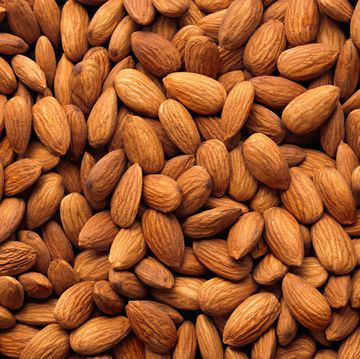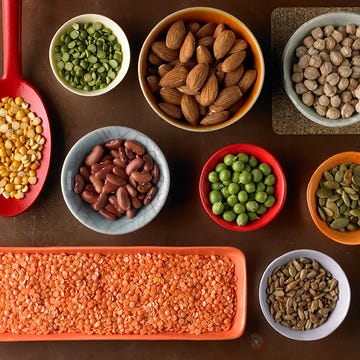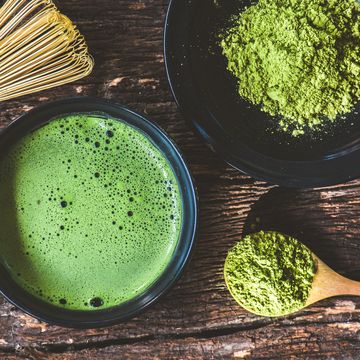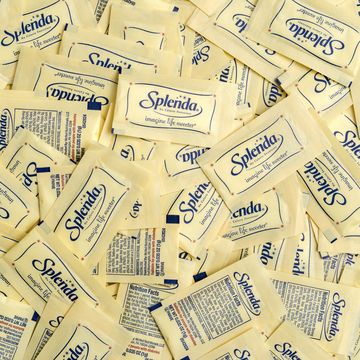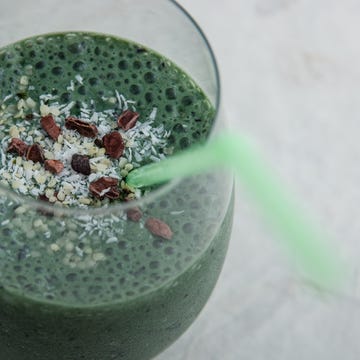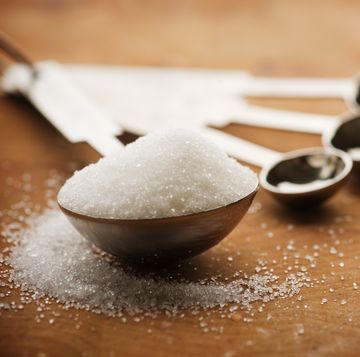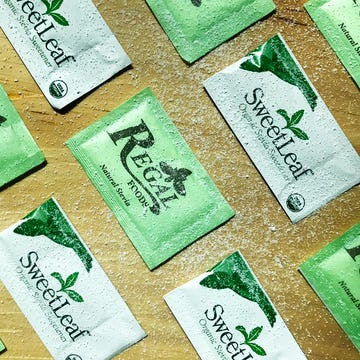Nearly 90 percent of the U.S. population doesn’t eat enough vegetables per day, according to the Dietary Guidelines for Americans, and about 80 percent don’t meet the recommended guidelines for fruit. Those guidelines include getting 2 to 3 cups of veggies a day and 1.5 to 2 cups of fruit.
To get the full nutritional benefits of fruits and veggies, including fiber, vitamins, minerals, and antioxidants, you need to eat the colors of the rainbow and a whole lot of them. This can seem difficult at times when fresh produce goes bad quick and can often get expensive. To make it easier to get your greens, green powders have become a pretty popular go-to for filling the produce quota. Manufacturers claim these supplements can serve up the nutrients of vegetables in just one scoop, among other health claims.
But do you gain the same benefits from green powders as you do from eating actual vegetables? Dietitians answer that question about these trendy supplements and what to know before you buy.
What are powdered greens?
“Powdered greens are typically dried vegetables and fruits processed into a powder and turned into a supplement,” says Mary Stewart, R.D., L.D., a registered dietitian and the founder of Cultivate Nutrition in Dallas.
Greens powders are made via one of two methods, or a combination of both:
- Dehydration: Ingredients are dried then crushed into a powder
- Extraction: The ingredient’s juice is extracted, dried, then turned into a powder
Using green powders is easy. You put a scoop of the powder in a blender cup, add water, and shake for about 30 seconds. In general, one glass of the greens will likely deliver these ingredients:
- Leafy greens, such as collards, kale, parsley, and spinach
- Grasses, for example, alfalfa grass, barley grass, oat grass, and wheatgrass
- Seaweed, in the form of chlorella, dulse, kelp, or spirulina
- Other antioxidant-rich vegetables and fruits, like acai, blueberries, broccoli, beets, cabbage, carrots, raspberries, and tomatoes
- Extracts, such as ginkgo biloba extract, grape seed extract, and green tea extract
- Enzymes, like amylase, cellulase, lipase, maitake mushroom extract, papain, protease, and shiitake mushroom extract
Beyond these ingredients, some formulations include herbs, probiotics, fibers, and natural sweeteners, such as stevia or monk fruit extract. The claims for each of these ingredients include taming inflammation, supporting gut health, and improving the flavor of these naturally bitter concoctions.
Speaking of flavor, some powdered greens can taste a bit off-putting at first, as they err on the grassy or vegetal side. For this reason, some users mix them with juice, blend into smoothies, sprinkle over salads, or stir into soups instead of sipping as-is.
In terms of what’s inside each serving, “the nutrient profile of powdered greens will vary quite differently compared to a serving of a single vegetable because the powdered greens are a concentrated form of a wide range of fruits and vegetables. You may have more or less of a specific micronutrient,” Stewart adds.
Vitamin A, vitamin C, vitamin K, biotin, calcium, chromium, folate, iron, iodine, magnesium, potassium, and selenium are often MVPs on many supplement facts panels for the widely-available, best-selling powdered greens on the market. These include:
- Athletic Greens (AG1)
- Organifi Green Juice Powder
- Amazing Grass Green Superfood
- Garden of Life Raw Organic Perfect Food
- Bloom Nutrition Greens & Superfoods
In general, these powdered greens might sound like a multivitamin and a salad mixed into one shelf-stable package, but are they worth it? Let’s examine the pros and cons.
What are the benefits of powdered greens?
1. They’re convenient
The first and most obvious reason to shake up your routine with green powders is that it’s fast, easy, and available on-the-go, explains Michelle Hyman, RD, a registered dietitian in New York City. A lot of green powder devotees start their day with a dose of antioxidants that requires zero shopping, washing, prepping, cooking, or refrigeration.
2. They’re nutrient-rich
Green powders are a quick and easy way to add a concentrated blend of produce-aisle items to your menu for the day; one scoop can pack in as many as 30 different fruits and vegetables.
A consistent dose may also improve blood levels of select vitamins in the blood, according to a November 2019 study in the International Journal for Vitamin and Nutrition Research that looked at veggie and berry juice power. The nutrients and phytonutrients in certain vegetables included can help act as “armor” to protect the body from potentially disease-causing free radicals or bacterial or viral invaders.
3. They may help stabilize blood sugar
One small study in the October 2019 edition of BioMed Research International found that adding a vegetable powder to a meal with refined carbohydrates may help support healthy glucose and insulin responses within the body—resulting in fewer blood sugar roller coasters.
4. They may support brain health
The beta-carotene, folate, lutein, vitamin K, and other nutrients in green vegetables help keep your brain sharper longer, several researchers have found, so it stands to reason that drinking veggies with these micronutrients might offer a similar brain boost. In fact, one February 2017 meta-analysis in the journal Frontiers in Aging Neuroscience found that for each 100 gram increase in fruit and vegetable consumption per day, participants had about 13 percent lower risk for dementia and cognitive impairment.
Important to note: Some of the nutritional benefits, including a good portion of the fiber, are lost during the dehydration process, so it’s not an exact one-for-one swap when comparing green powders to real veggies. More research is needed about how many micronutrients we can actually process and put to good use from these powders.
5. You can your lower risk for dehydration
For runners, “depending on the frequency and intensity of workouts, one serving of powdered greens can serve as a healthy part of one’s daily routine. When we get our heart rate up and sweat for an extended period of time, it is important to replenish our lost fluids and electrolytes and to consume ample antioxidants to properly recover,” Stewart says.
Mix your green powder with 8 to 12 ounces of water to help restore fluid levels after your sweat sesh and you get extra hydration with your nutrients.
What are the drawbacks of powdered greens?
1. Some brands are unregulated
Green powders are a dietary supplement, which is not regulated by the FDA, Hyman explains. In a 2016 report, Consumer Labs discovered that four of 13 commonly-sold green powder products were contaminated with lead, and others included trace amounts of arsenic and cadmium. Frequent exposure to or intake of heavy metals can negatively impact the immune system, kidneys, reproduction, and the central nervous system.
However, some brands, including AG1, are tested at an independent lab to ensure safety. Be sure to examine the package and look for labels like NSF, USP, and ConsumerLab, which denote the product has been third-party tested, which helps to verify that it contains what it says it does—and nothing else.
2. They may interact with certain medications
“Even healthy nutrients in excess may result in a poor reaction especially for those taking medications or other supplements,” Stewart says. Pregnant and breastfeeding women, children, and anyone on any other medicine—especially Coumadin and Warfarin, found in many blood thinner medications, which require consistent vitamin K intake—should consult with their physician before taking powdered greens.
Likewise, some green powders can hide ingredients that might interact with birth control pills, so it is important to carefully read the warning labels and if you take any medications, ask your doctor if it is safe for you to drink green powders.
3. You may want to spend your money on food, not powder
“If you’re eating a balanced diet that is packed with produce, as well as sources of probiotics, I don’t think you’re going to see a benefit,” explains Frances Largeman-Roth, RDN, a Dobbs Ferry, New York-based nutrition expert and the author of The Smoothie Plan. “Plus, compared to just drinking water, they’re expensive.”
Green powders usually clock in at $1.50 to $4 per serving. “I’d prefer my clients use their hard-earned money on buying actual fruits and vegetables,” Hyman says. “Consuming these powders may result in individuals thinking they don’t need to eat any fruit or vegetables for the day because the blends contain multiple sources of vegetables.”
4. You’re missing out on the filling fiber
One major reason why the real deal—fresh and frozen fruits and vegetables—will always earn top ranks from Hyman is that green powders get stripped of most of the fiber found in whole produce. That means “they don’t provide the same satiating effect as eating fruits and vegetables,” she says. And you don’t get the digestion support that fiber provides.
Most green powders deliver 1 to 2 grams of fiber per serving, which is much less than what you get in greens like kale, which packs 3 grams of fiber per cup, while berries, like raspberries, offer 8 grams per cup.
“If a serving of the powder is the only source of produce for the day, the fiber in the powder pales in comparison to eating a few servings of the actual produce,” Hyman adds.
Plus, the simple act of chewing whole fruits and veggies can also make you feel satiated faster.
5. You might forget about other colors besides green veggies
“I don’t think it’s necessary to prioritize only green vegetables, either,” Hyman continues. “I encourage clients to ‘eat the rainbow’ and focus on consuming various colors of produce,” including seasonal fruits and vegetables that are red, orange, yellow, blue, purple, brown and white.
The bottom line about powdered greens
Supplements like green powders should not replace whole fruits and veggies. “If you’re not getting enough greens in your diet and you don’t think it’s realistic to add them to your diet through real food, you could consider having a serving of these powdered greens daily. But don’t replace your daily salad with them,” Largeman-Roth says.
Stewart reminds her clients that “you can’t ‘out supplement’ a poor diet,” and advises them to think of food first. The foundation of any diet should include minimally-processed whole foods with plenty of high-fiber carbohydrates (like veggies and whole grains), healthy fats, and lean protein. If you struggle to sit down for a meal, consider making a whole foods smoothie with frozen baby spinach or kale, milk or non-dairy milk, and frozen fruit, rather than just sipping powdered greens.
“Powdered greens can be a great way to fill in any nutritional gaps especially if you are on-the-go, traveling, deficient in certain micronutrients or need additional antioxidants to support physical or mental stress on the body. Adding powdered greens is not always necessary, but for some, can certainly be beneficial and supportive to your health goals,” Stewart says.
Although green powders are not necessary, they’re probably not going to harm your health either. That is, as long as you choose third-party tested and verified brands, so you know that the supplement facts are actually truthful—and that the canister actually includes the ingredients it says it does, without extras.
If you do decide to purchase a green powder, it’s also important to focus on your overall fruit and vegetable consumption while drinking plenty of water.

Karla Walsh is a Des Moines, Iowa-based freelance writer, editor, freelance writing coach and level one sommelier who balances her love of food and drink with her passion for fitness (or tries to, at least!). She has over 15 years of professional experience covering food, wine, travel, nutrition, health, fitness, psychology, beauty, relationships and beyond.





